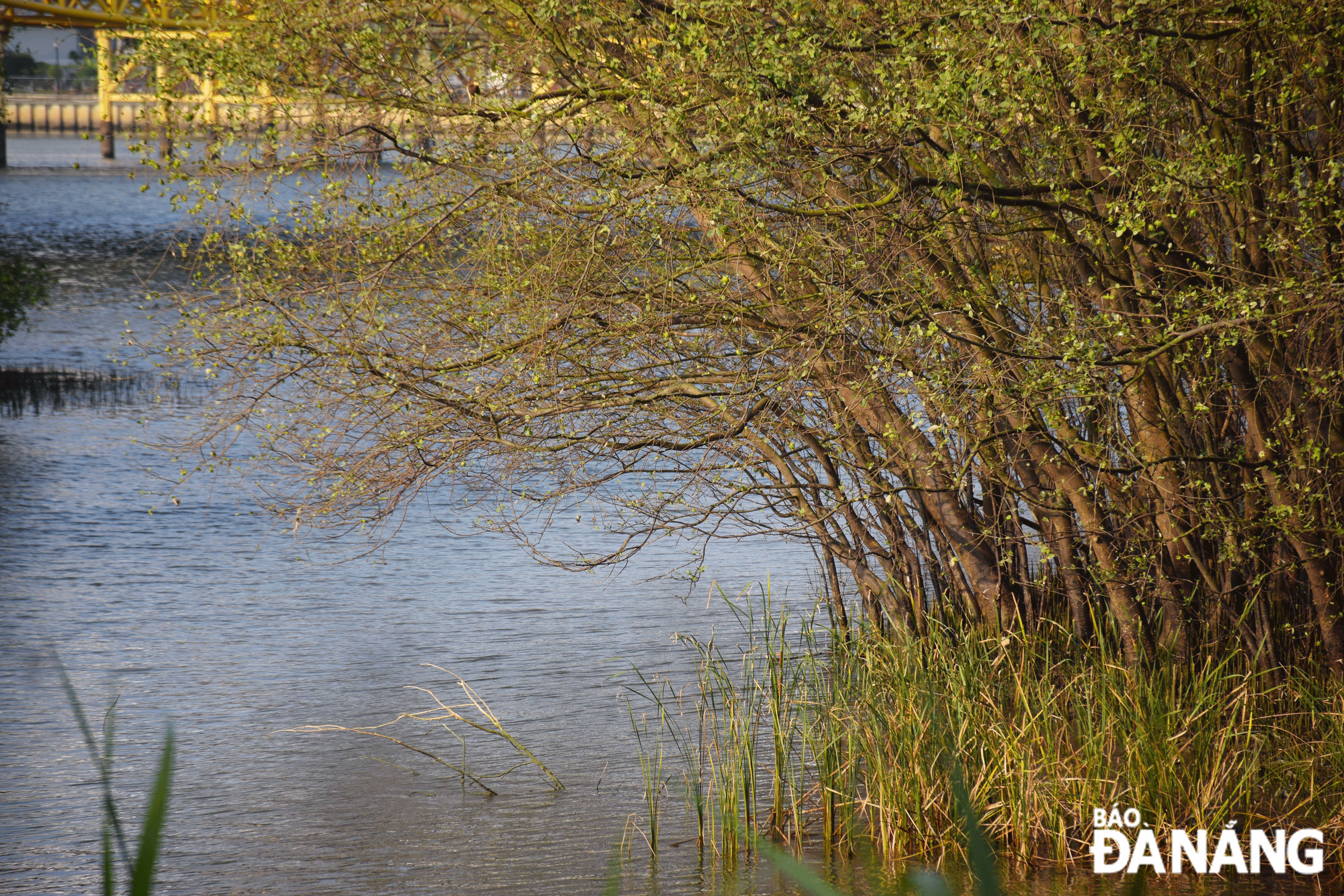Given the value of the Han River in general and the wetlands around Dao Xanh (Xanh Island) in particular, what should we do to effectively utilize this natural potential while preserving the inherent beauty of the natural landscape? This is not only the responsibility of managers and scientists but also requires the collective effort of the community to preserve and protect the wetland ecosystem resources.

After implementing legal regulations, all activities within the wetland ecosystem will be strictly managed. Photo: Doan Luong
Completeing connectivity of public park structure
Speaking about the proposal to protect and sustainably develop the wetland ecosystem along the Han River, Mr Nguyen Van Duy, Vice Chairman of Hai Chau District People's Committee, stated that the project stems from the reality that the density of urban green space in the district is very low due to rapid urbanization, with the green space ratio falling short of the set goals.
"The landscape area along the Han River and the Cam Le River on the west bank of Hai Chau District has naturally growing mangrove trees, accompanied by various bird species, including migratory birds, creating a peaceful scene amidst a bustling urban area. To capitalize on this advantage, Hai Chau District leaders came up with the idea of protecting and enhancing this landscape ecosystem to serve the public and tourists. Public spaces along the river provide high relaxation value, improving the spiritual life of urban residents and visitors to Da Nang. This balances the vibrant lifestyle with the bustling commercial and service areas. This quiet space complements the overall structure of the public spaces along the Han and Cam Le Rivers," Mr Duy analyzed.
Accordingly, the Hai Chau District People's Committee has developed a detailed and specific outline for effective and sustainable exploitation. First, the district will evaluate the valuable biodiversity of this mangrove ecosystem. Second, they will propose the creation of public landscapes along the riverbanks and walking paths using wood or eco-friendly materials, allowing residents and visitors to appreciate the riverside landscape. Mr Duy noted that a park's structure typically includes active and passive sections. The active part is for various activities, while the passive part is for rest and tranquility.
As explained by Mr Duy, activities at the pedestrian street from Bach Dang to the APEC Park and the Nguyen Van Troi Bridge are very lively these days. This area functions as a large park for the city, with the active part of urban space already established. Now, the district will add passive elements like seating areas and walking paths without additional constructions that would affect the ecosystem. Visitors and residents can relax and watch birds. However, maintaining naturalness is crucial for attracting birds, so some areas of the ecosystem must remain undisturbed.

Managing and preserving the wetland ecosystem will help native plant species thrive. Photo: Doan Luong
Building legal frameworks for strict protection
The current difficulty in exploiting the wetlands around the Xanh Island is that the Hai Chau District government has not yet clearly identified the water surface area leased by the city to a Vietnamese multi-sector business group.
Mrs Vo Thi Kim Ngan, Deputy Head of the Natural Resources and Environment Department of Hai Chau District, said that in the near future, the district will direct specialized agencies such as urban management and natural resources and environment departments to coordinate with relevant units to define the boundaries protecting the wetland ecosystem in the Xanh Island area and along the Han River to the Hoa Xuan Bridge. They will determine the specific area leased to businesses to make further proposals. After that, they will contract experts and specialized units to survey the flora and fauna in the area to devise plans for exploitation and protection.
Recently, Hai Chau District leaders have conducted surveys, inviting scientists from universities specializing in biodiversity conservation and landscape architectural planning to assess the current status. Consequently, they have outlined the implementation of the idea of conserving the riverside wetland ecosystem and promoting landscape value. Additionally, experts from the University of Da Nang have organized classes to educate student groups about the ecosystem.
Master's degree holder Pham Tai Minh, working for Teaching and Research Team of Environmental and Biological Resources- University of Da Nang (UD) believes that when approaching birds and storks on the Xanh Island, it's essential to ensure their privacy and freedom. The Xanh Island is planned for mangrove planting, with urgent preservation of species such as the mangrove apple and nipa palm. This approach creates a shield against the impact of waves and wind, forming a green space for the urban centre. As the vegetation flourishes, a truly green living space will emerge, encouraging neighboring localities to follow suit.
To manage and effectively exploit the wetland ecosystem on the Han River, Associate Professor Dr Vo Van Minh, Rector of the University of Science and Education (UD), noted that alongside awareness, two significant issues need to pay attention to is legality and principles. Legally, this involves the Environmental Protection Law and the Biodiversity Law. Authorities and residents must understand the usage boundaries and protected areas, planning methodically to propose long-term management projects. Principally, scientific evaluation of the Han River’s characteristics, environment, sediment content, suitable plants is necessary. However, achieving this requires persistence and high determination from city leaders and strong consensus from the public.
"Public spaces along the river provide high relaxation value, improving the spiritual life of urban residents and visitors to Da Nang. This balances the vibrant lifestyle with the bustling commercial and service areas" stated by Mr Nguyen Van Duy, Vice Chairman of Hai Chau District People's Committee.
Reporting by Doan Luong, Truong An - Translating by Truc Vy
















